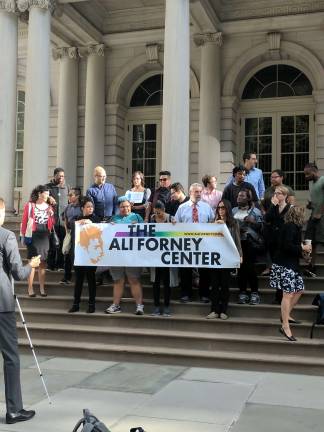helping homeless Youth

City Council members presented four pieces of legislation last Thursday that would help the city’s efforts with combating youth homelessness.
The legislation included raising the age for runaway homeless youth from 21 to 24; streamlining youth intake at the Department of Homeless Services (DHS) from the Department of Youth and Community Development (DYCD); extending how long youth can stay in a shelter from 30 to 60 days, and 120 days with guardian permission; and requiring DYCD to never turn away a homeless youth.
“While we support the intent of the following bills,” said Commissioner Bill Chong of DYCD, “it would be extremely challenging for the Administration to implement these measures without adequate funding.”
“Young people who face the cold hard truth of aging out,” Alexander Perez, 24, who testified at the city council hearing for the Committee on Youth Services on Thursday, “now [have] to understand why things like funding come in between the city’s youth having a semblance of what home is.”
DHS currently has three shelters that solely house homeless youth with a capacity of 167 beds, according to Council Member Steve Levin.
“Clearly there are not enough beds for this population,” Levin said.
Chong said that 525 beds were available through the DYCD Runaway Homeless Youth (RHY) drop-in centers and crisis shelters, and 128 are in-progress to being implemented. DYCD also plans on increasing the price per bed to $47,000, allowing greater funding for services per youth.
“Runaway homeless youth are commonly referred to as one of the most vulnerable populations in New York,” Councilman Corey Johnson said Thursday at the hearing. “It doesn’t fully describe the gruesome reality of physical, mental, emotional and sexual abuse and exploitation that young people endure when they are forced to live on the street.”
Typically, DYCD claims to serve an average of 474 youth each night, with 50 beds available, according to Susan Haskell, the deputy commissioner of youth services.
“We can find a bed for any young person,” Haskell said. “The number of truly unsheltered youth has been very small for the past couple of years, around 44 unsheltered age 21 or under ... many more are unstably housed.”
However, there appears to be some discrepancies between the numbers obtained by DYCD and other sources. In July 2017, there was a reported total of 60,856 homeless people sleeping in the New York City municipal shelter system, according to the Coalition for the Homeless. At one downtown drop-in center, The Door, which primarily provides services for youth development, 45 percent of young people can’t get shelter when they request it, according to Sarah Meckler, the center’s assistant director of special populations.
“We’re hearing two things that don’t jive,” Levin said. “Honestly it’s up to [DYCD] and the providers to explain ... why you’re not on the same page.”
During the hearing, Levin received information that on the previous night, the Ali Forney Center on West 35th Street reported that they had 12 youths in their drop-in center overnight because of a lack of crisis beds to send them to. The Ali Forney Center is a 24-hour drop-in center that has become the “largest agency dedicated to LGBTQ homeless youths in the country,” according to their website. The center serves nearly 1,400 youth annually and provides over 70,000 meals annually.
Senior director Randolf Scott of DYCD gave out his number during the hearing, 1-646-457-2705, to ensure that no youth goes without a bed.
The local laws are planned to take effect on Jan. 1, 2018.